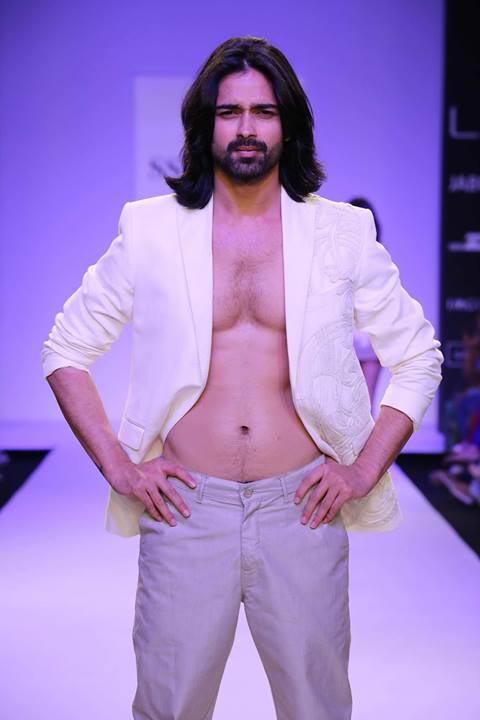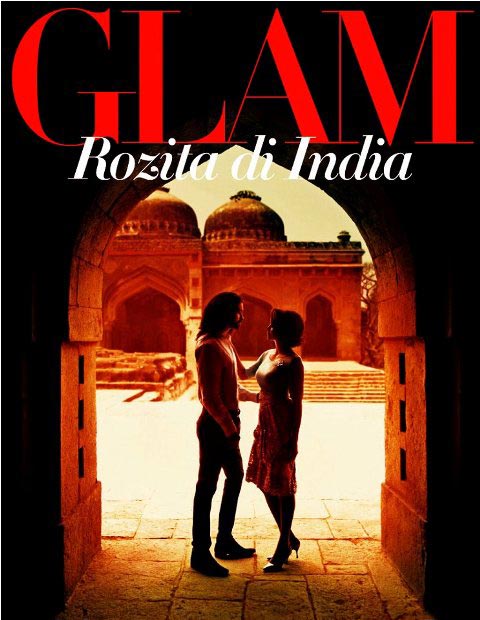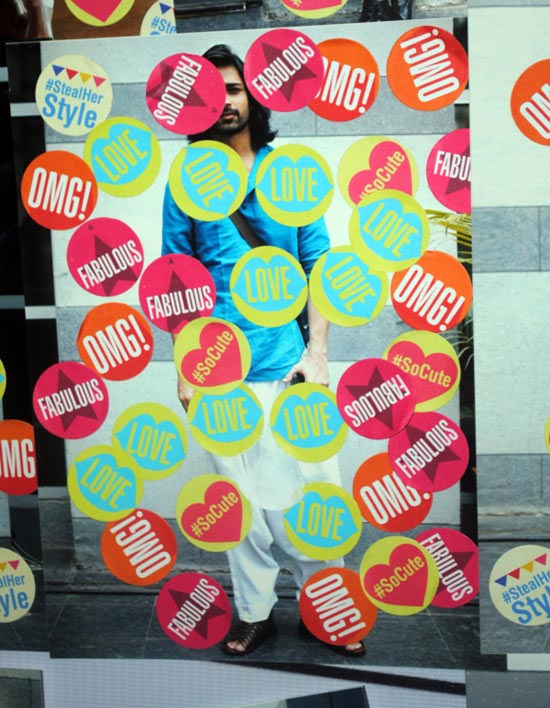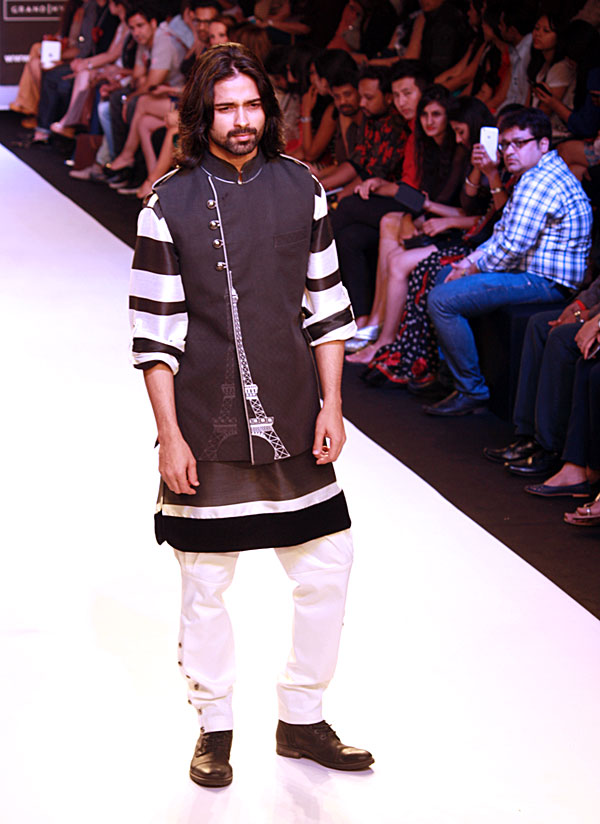Photographs: Courtesy Lakme Fashion Week Divya Nair/Rediff.com
'Just like every father in North India, mine wanted me to enroll for the Civil Services.'
'It was difficult to make him understand that I loved modelling. When I refused to listen to him, he stopped sending me money. I was left to fend for myself.'
'When I started, I was told if you don't have a godfather, it's difficult to survive in the industry. I can tell you that's not the case.'
Top model Amit Ranjan gets candid with Rediff.com's Divya Nair...
At 21, he flipped burgers for a living instead of studying for the civil service exam as his family intended. Amit Ranjan's path to fame was paved with challenges.
Amit, who hails from Patna, has the physique and looks needed to be a top model.
Former Marie Claire editor Shefali Vasudev describes him as 'Jesus Christ painted by Michelangelo' in her book Powder Room that chronicles the Indian fashion industry.
A graduate from Delhi University, Amit bagged his first modelling assignment when he was 21.
Today, he is the poster boy for brands like Airtel, Fastrack, Mountain Dew and Van Heusen.
In a candid conversation at the Lakme Fashion Week -- please check out our special coverage here -- the 27-year-old model and aspiring actor opens up about his struggles and how the experiences have changed his life.
How come, modelling?
My father is a CA.
Just like every father in North India, he wanted me to enroll for the Civil Services.
To please him, I did Hindi Honours at Deshbandhu College in Delhi.
In college, I participated in fashion shows.
After I finished college, in 2006, I got a call to shoot an ad for Carlton London. That was my first modelling assignment.
How did your family react?
My father was very upset. He was like: How will modelling secure your future? What if you don't get good offers? Why don't you try appearing for the Civil Services?
It was difficult to make him understand that I loved modelling.
When I refused to listen, he gradually stopped sending me money. I was left to fend for myself.
I had to pay my rent and food expenses. So I took up a job in McDonalds.
I worked in shifts and spent the rest of the time auditioning for model contests. Those were tough times.
Please click NEXT to continue reading...
'You don't need a godfather to make it big'
Image: Amit Ranjan on the cover of the Malaysian magazine Glam with actor Rozita Che Wan.Photographs: Courtesy Glam Malaysia Divya Nair/Rediff.com
What helped you to keep going?
No matter how hard I tried, my family would not listen.
No one in my family, friends circle or in the neighbourhood had done modelling or was even remotely related to the fashion industry. So it was all the more difficult to convince them.
The only way I could make them understand was by letting my work do the talking.
In 2006, I applied for the Gladrags Mega Model contest. More than 1,000 people auditioned for it.
I made it to the top 300 and was noticed by Gladrags Editor Maureen Wadia.
I did not make it to the finals, but I realised that if I was picked out from the crowd, there has to be something special and different about me and I should not let go of this dream so easily.
What distinguishes a successful model from an average one?
You need to have a good figure and height -- minimum 5 feet 11 inches; height and weight have to be proportionate, that's basic.
Besides that, you must display passion, confidence and have the ability to carry off anything and everything in style.
If you are in the audience, you can make out from the first few steps whether a model is good or not.
You either have it or you don't.
Tell us about your first modelling experience.
I was nervous before I entered the studio. Once I got there, I knew what my role was and I grew confident.
The Carlton London shoot required us to pose in their latest shoes. Since I love boots, it was fun.
Was it easy to get assignments after that?
Not really. It took me a while to build my network and get noticed. The Gladrags contest was the turning point.
In 2007, I auditioned for Face of Elite Model Management. They are the topmost model management firm in the country.
I got selected and got a two-year contract which lasted up to 2009. They renewed the contract and I got to work with them for a good five years.
Through the contract, I got to shoot for brands like Airtel, Fastrack and Mountain Dew.
I also did an international photo shoot for Glam magazine with Malaysian actor Rozita Che Wan which also became the magazine's cover photo.
I'm an independent model now. I don't work with any agency, so if people want to hire me, they have to approach me directly.
Please click NEXT to continue reading...
'You don't need a godfather to make it big'
Image: Amit Ranjan's photograph at the Lakme Fashion Week's style wall in Mumbai was a head turner.Photographs: Reuben NV/Rediff.com Divya Nair/Rediff.com
Describe your personal sense of style.
I like smart casuals and prefer the rugged, washed down look.
I'm obsessed with leather boots and wear them with almost everything.
Where do you shop?
I'm not so brand conscious; if I like something while walking down the streets, I don't bother to check which brand it is from.
If I have to pick from a store, I always choose Zara and Lecoanet.
What's your diet like?
I work out for at least an hour-and-a-half in the morning. That's one hour of weight training and 30 minutes of cardio.
My breakfast comprises five eggs (without the yolk), a bowl of muesli with a glass of toned milk.
Lunch is four rotis, dal, sabzi, two spoons of rice and salad.
I have a sweet tooth, so it's difficult to resist dessert. Rasgulla is my favourite.
I avoid junk like fries, bread and burgers.
What is the rewarding part of being a model?
Attention.
That's the best part of being a model.
When people notice you, your hard work, you feel good.
You get to travel a lot, explore new experiences and work with new people, share ideas and learn new things.
If you are passionate about modelling and fashion, it's the best thing to happen to you.
What's the flipside of being a model?
It's a short-lived career, so it's an advantage if you start early.
If you're a girl, by the time you reach 27, 28, your career is almost over.
For male models, there are different challenges.
Among the designers you've worked with, who's your favourite?
I have walked for Anita Dongre, Sabyasachi Mukherji, Manish Malhotra, Wendell Rodricks, Rocky S, Rohit Bal, Narendra Kumar Ahmed, Ashish Soni, JJ Vallaya and Rajesh Pratap Singh.
Each has a distinct style of working and their designs are unique.
It's difficult to pick one, but I personally enjoyed walking for Rocky S for a Blender's Pride event, because it was my first event and he was the first big designer I was working with.
I also relate to the styles of Rajesh Pratap (Singh), Lecoanet and Hemant, Wendell Rodricks and Rohit Bal.
Please click NEXT to continue reading...
'You don't need a godfather to make it big'
Image: Sometimes you're required to wear strange outfits and accessories, says Amit Ranjan.Photographs: Courtesy Lakme Fashion Week Divya Nair/Rediff.com
What are the challenges male models face?
There is no dearth of competition in India. Take the case of Lakme. The ratio of female models to male models is 4: 1.
In a line-up of 20 models, there are only four or five male models as against 15, 16 female models. And every year, a new set of men compete for these five roles.
When it comes to remuneration, the European countries pay you triple.
In India, there are very few menswear designers. So, there are comparatively fewer opportunities for a male model.
Things are slowly changing. With designers like Narendra Kumar and Rajendra Pratap Singh doing more shows in a year, new avenues are opening up for us.
What is the remuneration offered to male models in India?
If you're a fresher, you get anything between Rs 3,000 to Rs 5,000 for one show.
If you are experienced, you can earn up to Rs 30,000 per show in India. My first pay cheque for Carlton London was Rs 3,000.
Which male models do you admire?
I've always admired Milind Soman. He's perhaps India's first male supermodel who has inspired a whole generation to pursue modelling in the country.
When I met him during one of the shows, I realised he is very down to earth and a good human being.
Rahul Dev and Jas Arora are equally good.
What changes have you seen in the industry since you entered?
When I started off, there was a huge demand for wide framed men -- bulky, masculine. If you had long hair, it was an asset. Even the clothes were designed keeping these factors in mind.
Over the last few years, the frame has become leaner. We are going the European way.
The focus now is on men who are lean and fit.
I had to crop my hair and grow a stubble to match the requirements.
Have you ever goofed up on the ramp?
Oh yes! In 2010, I was walking for Rajesh Pratap Singh in Delhi and it was an outdoor stage.
The runway was filled with dew and as I stepped on it, I almost slipped. I did not trip or fall, but it was difficult to walk.
Sometimes you are required to wear strange outfits and accessories. You have to practice how to walk with confidence.
Please click NEXT to continue reading...
'You don't need a godfather to make it big'
Image: Amit Ranjan walks for Archana Kochhar.Photographs: Reuben NV/Rediff.com Divya Nair/Rediff.com
Lessons from your career so far...
When I started my career, I was told that if you don't have a godfather, it's difficult to survive in the industry. Now that I have spent a fair amount of years in this profession, I can tell you that it's not the case.
If you are focused, determined, and believe in your talent, you need not take any shortcuts.
Just be honest and people will gradually but definitely notice you. The shortcut route will get you instant fame and perhaps more success, but eventually you are cheating yourself.
Always take the long route -- with hard work, success comes late, but you'll feel proud of it!
You said modelling is a short-lived career. What will you do when it's over?
I'm getting quite a few offers from Bollywood. I was recently offered a role in the film 3G which I refused.
I'm in talks with some directors and will make an official announcement soon.
A few years down the line, I want to start an institute to train young talent and guide them on how to pursue a career in fashion.
Your advice to those wanting to pursue a career in the fashion industry.
- Never ever quit your education or job to become a model.
- You can take up small assignments while you're still in college, but pursue it part-time, like a hobby.
- Once you have a steady flow of assignments you may consider taking a break to pursue modelling full time.
- The stakes are really high. Don't get carried away with the glitz and glamour you see on the ramp.
- There's a great deal of hard work and struggle that goes behind it. So, come prepared.
- If you are passionate and willing, it's definitely worth a shot.






Comment
article